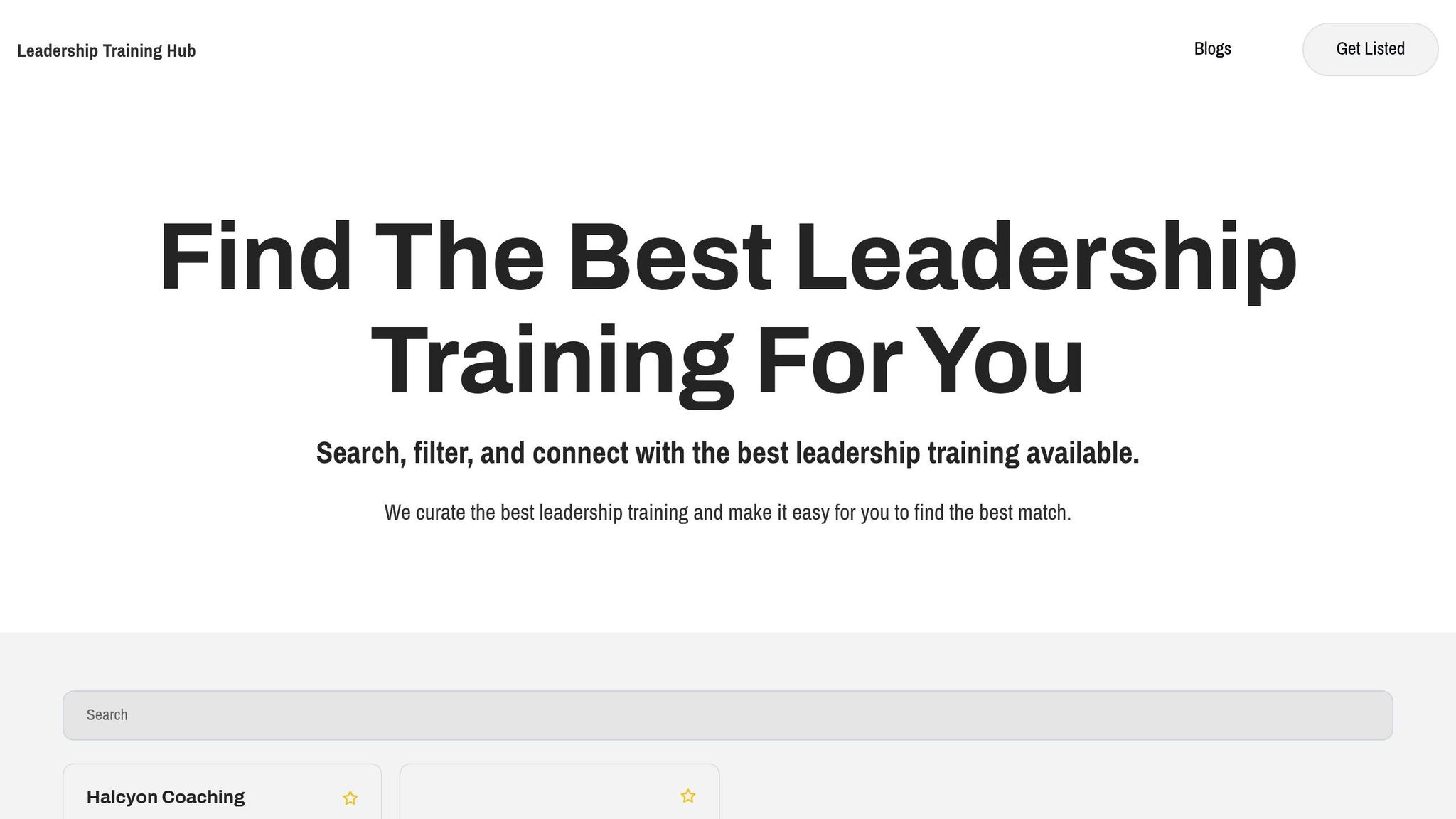Executive transitions are high-stakes moments. Around 27–60% of transitions fail within 18 months, costing organisations up to 200% of the executive’s salary. These changes also disrupt teams, leading to a 40% rise in attrition within six months. Coaching can mitigate these challenges.
What works? One-on-one coaching provides personalised support to help leaders navigate new roles, manage stress, and build credibility. Three main approaches exist:
- In-person coaching: Strong personal connection but costly and less flexible.
- Virtual coaching: Accessible, cost-effective, and flexible but less personal.
- External providers: Offer expertise and objectivity but vary in cost and availability.
Each method suits different needs, and platforms like Leadership Training Hub simplify finding the right coach. The goal? Help executives contribute faster and more effectively while reducing risks.
How to Master Executive Transitions | Navid Nazemian | HR Leaders Podcast
1. In-Person Coaching
In-person coaching is the classic method of providing support during executive transitions, involving face-to-face meetings between the coach and the client. This approach allows for direct interaction, which helps in interpreting non-verbal cues and building a stronger connection. The physical setting often encourages deeper engagement with the challenges executives face during transitional periods. Below, we’ll explore how factors like accessibility, cost, and flexibility influence this method.
Accessibility
The availability of in-person coaching is often influenced by location and the proximity of qualified coaches. Executives based in major UK cities such as London, Manchester, or Edinburgh generally have access to a wider pool of experienced coaches. However, those in more remote areas may find fewer options, potentially requiring travel or settling for coaches with less specialised expertise.
Scheduling can also be a hurdle. Both the coach and the executive must align their calendars, factoring in travel time, venue availability, and possible disruptions like transport delays or adverse weather. For executives already juggling demanding schedules, these logistical challenges can add stress during a critical transition period.
Cost
In-person coaching tends to come with higher costs due to the added expenses involved. Coaches often include travel, venue hire, and, in some cases, accommodation in their pricing. These overheads make in-person sessions more expensive compared to virtual options.
The average hourly rate for executive coaching is around £280, with packages ranging from £4,000 to over £24,000, depending on the scope of services . For in-person coaching, rates often lean towards the higher end, with premium sessions sometimes exceeding £800 per session. These fees reflect not only the coach’s expertise but also the logistical complexities of delivering face-to-face sessions.
Flexibility
Compared to virtual coaching, in-person sessions offer less flexibility. Coordinating schedules becomes more challenging when travel and venue arrangements are involved. Last-minute changes or cancellations can be particularly disruptive and costly, especially if travel or venue bookings are non-refundable.
Additionally, the format of in-person coaching makes quick check-ins or emergency sessions impractical. A brief 30-minute session, for example, becomes less feasible when travel time is included. This limitation can reduce the immediacy of support during critical moments, though it is balanced by the unique benefits of face-to-face interaction.
Effectiveness
The strength of in-person coaching lies in the depth of human connection it fosters. Meeting face-to-face allows coaches to pick up on non-verbal cues like body language and facial expressions, offering insights that can guide more tailored and impactful coaching strategies. This level of connection helps coaches better understand their clients’ emotions and motivations.
The physical setting also creates a focused and distraction-free environment, enabling executives to fully engage with their challenges. This can lead to more meaningful breakthroughs and insights during sessions. However, the overall effectiveness depends on the quality of the coach-client relationship and the specific needs of the executive.
While in-person coaching offers a rich and engaging experience, it’s important to weigh its benefits against the practical limitations of cost, scheduling, and accessibility. For some, the depth of interaction it provides may justify the investment, but it’s not always the most practical choice for every situation.
2. Virtual Coaching
Virtual coaching offers a modern alternative to traditional in-person methods by using digital tools to provide remote executive support. With 85% of organisations now incorporating virtual coaching programmes, this approach removes geographical limitations and simplifies logistics, making it easier for executives to access support through video conferencing platforms like Zoom and Microsoft Teams. It not only broadens access but also encourages more flexible and engaging interactions.
Accessibility
One major benefit of virtual coaching is that it eliminates the geographical barriers that often restrict access to top-tier executive coaches. Regardless of where an executive is located, they can connect with leading professionals from around the world. This is a game-changer for those in smaller cities or rural areas, where access to specialised coaching might otherwise be limited.
Additionally, virtual coaching accommodates busy schedules and mobility challenges. Executives can take part in sessions from their homes, offices, or even while travelling, making it easier to align coaching with their daily routines. The flexibility to schedule sessions across different time zones further enhances its appeal.
Cost
Virtual coaching often comes with a lower price tag compared to in-person options. For instance, Business Training Works, Inc. offers a three-month virtual coaching programme with monthly calls for £3,200, while the same duration in a combined in-person and virtual format costs £4,800.
| Programme Length | Virtual Coaching | In-Person and Virtual Coaching |
|---|---|---|
| Three Months (Monthly Calls) | £3,200 | £4,800 |
| Six Months (Monthly Calls) | £4,500 | £6,000 |
| Twelve Months (Monthly Calls) | £8,500 | £10,000 |
| Twelve Weeks (Weekly Calls) | £8,500 | £10,000 |
| Twenty-Six Weeks (Weekly Calls) | £15,000 | £16,500 |
| Fifty-Two Weeks (Weekly Calls) | £24,000 | £25,500 |
These savings are largely due to reduced travel costs, venue fees, and other expenses that are typically passed on to clients. This affordability makes executive coaching accessible to a wider range of organisations and individuals.
Flexibility
Virtual coaching is particularly well-suited to the unpredictable nature of executive schedules. Sessions can be easily rescheduled, and the format allows for real-time support during critical moments. For example, executives can arrange quick check-ins during high-pressure situations or extend sessions when tackling complex challenges. This adaptability ensures coaching remains aligned with their immediate needs.
The convenience of virtual coaching also integrates seamlessly into daily routines. Executives can participate in sessions early in the morning, between meetings, or even during a layover, making it an efficient and unobtrusive part of their workflow. Notably, 68% of employees have reported feeling more connected to their mentors or coaches through virtual interactions.
Effectiveness
Virtual coaching fosters an environment that many executives find conducive to honest and reflective discussions. The physical distance provided by the digital format often creates a sense of psychological safety, encouraging more open conversations about challenges. This dynamic is especially helpful for reserved individuals who might find it easier to express themselves in a virtual setting.
"Virtual coaching helps people go deeper faster. The medium creates an interesting combination of intimate-yet-safe." - Cynthia Burnham, Executive Coach
"Virtual sessions force the coach and the coachee to focus intently on each other. No distractions. This process fosters a distinct intimacy. I find when I am coaching someone who is very reserved and private, the distance of the technology makes it easier for them to be open and expressive." - Evelyn Rodstein, Executive Coach
Organisations that prioritise virtual coaching for remote employees have seen a 31% boost in engagement and productivity. While its success depends on an executive's comfort with technology and their ability to create a distraction-free environment, virtual coaching can match the impact of in-person sessions while offering unmatched convenience and accessibility.
sbb-itb-fa39ac2
3. External Coaching Providers from Leadership Training Hub

Leadership Training Hub connects executives with expert external coaches who specialise in areas like change management, organisational transformation, and leadership resilience. Unlike internal coaches, these professionals dedicate their careers to mastering the latest leadership practices and trends.
Accessibility
Leadership Training Hub’s directory and digital tools make it easy to connect with top-tier coaches, whether in-person or online, removing geographical limitations. Thanks to AI-powered scalability, even executives in remote locations or those with demanding travel schedules can access high-quality coaching.
This accessibility has caught the attention of major corporations. As CNN.com highlights: "Coaching is now part of the standard leadership development training for elite executives and talented up-and-comers at IBM, MOTOROLA, CHASE, and HP". Such flexible options allow for tailored coaching experiences that fit seamlessly into busy executive lives.
Cost
External coaching providers typically charge around £350 per hour, with rates ranging from £200 to £3,000 per hour, depending on the coach’s expertise. Despite the cost, the return on investment (ROI) can be striking. According to the International Coaching Federation (ICF), 86% of companies surveyed reported positive ROI from coaching, with some achieving ROIs as high as 50x (19%) or between 10x and 49x (28%).
Leadership Training Hub offers a pricing structure designed to accommodate organisations of all sizes. Options range from a free Basic Plan to the All in package at £2,999. Specific programmes vary widely in cost, such as Leadership Academy™ starting at £3,500 per leader, while more extensive offerings like Tandem Coaching’s Team Pro coaching can cost up to £26,000. These programmes balance premium expertise with flexible pricing to meet diverse organisational needs.
Flexibility
External coaching providers excel at tailoring programmes to fit individual leadership styles and organisational contexts. Many offer flexible membership models and access to additional resources. Coaching engagements often incorporate methodologies grounded in adult transformational learning, ensuring they are relevant and impactful. Some providers even include transition readiness assessments to gauge leadership competencies, while others focus on setting measurable goals and tracking milestones.
This adaptability is especially valuable during periods of executive transition, where tailored support can make a significant difference.
Effectiveness
External coaching providers bring an unbiased perspective that’s invaluable during executive transitions. Free from internal company dynamics, they offer objective insights and specialised strategies that internal mentors may struggle to deliver. Their diverse experiences across organisations allow them to introduce new approaches and proven methods. For instance, structured programmes like CoachHub Executive™ help senior leaders enhance self-awareness and focus on impactful actions.
Leïla Salamat, a CoachHub Executive™ coach, describes the value of this process:
"Executive coaching offers a safe, confidential and non-judgmental space - leading to new insights, perspectives and actionable possibilities for the coachee".
Studies back up the effectiveness of external coaching in building stronger leadership teams. Teams with high trust and alignment outperform others by 23.5%. External coaches are particularly skilled at fostering these dynamics, making them an essential resource for senior executives. While internal coaches are well-suited for entry to mid-level employees, external expertise is often the best choice for senior leaders navigating critical transitions.
Advantages and Disadvantages
Building on the comparisons above, let’s break down the strengths and challenges of in-person, virtual, and external coaching providers. This overview highlights the key benefits and limitations of each approach, helping organisations make informed decisions during executive transitions.
In-person coaching stands out for its ability to build strong personal connections. Face-to-face interaction allows coaches to pick up on non-verbal cues like body language, which can deepen understanding and trust. Group sessions also benefit from this setting, fostering team cohesion. On the downside, in-person coaching can be logistically tricky and expensive, with costs driven up by travel and venue requirements.
Virtual coaching is a game-changer for accessibility, connecting leaders with coaches worldwide. Its flexibility means busy executives can slot sessions into their schedules with minimal disruption. It’s also easier on the budget - studies show that virtual coaching can reduce costs by up to 22%. For example, in Germany, 59% of coaching sessions were conducted online, with 73% of clients reporting positive experiences and 89% valuing the flexibility. However, virtual coaching does have its drawbacks, such as less personal interaction and the occasional technical hiccup. Still, its adaptability can be crucial during periods of rapid organisational change.
External coaching providers bring specialised expertise and an objective perspective, which can be especially useful during complex transitions. They offer fresh insights and tailored solutions, often designing programmes that align with an organisation’s unique needs and budget. This flexibility makes external providers a strong option for organisations seeking custom support.
| Criteria | In-Person Coaching | Virtual Coaching | External Providers |
|---|---|---|---|
| Accessibility | Limited by location | Accessible globally | Broad network availability |
| Cost | High due to travel and venue expenses | Generally lower (up to 22% savings) | Pricing varies by provider |
| Flexibility | Fixed schedules, travel required | Highly flexible scheduling | Customisable to organisational needs |
| Personal Interaction | Strong, immediate feedback | Limited by digital barriers | Offers an unbiased, external perspective |
| Effectiveness | Ideal for trust-building | 73% positive client feedback | Provides targeted insights for transitions |
Choosing the right coaching method depends on factors like the executive’s goals, budget, and preferred learning style. Many organisations now opt for hybrid approaches, blending the strengths of these methods to create tailored, effective coaching experiences.
Conclusion
There's no one-size-fits-all solution when it comes to coaching during executive transitions. In-person coaching fosters trust through face-to-face interaction and non-verbal communication, while virtual coaching provides the advantage of flexibility and cost savings. Bringing in external coaches can add valuable expertise and impartial perspectives, which are often critical during complex leadership shifts.
The secret to success lies in aligning the coaching approach with the executive's specific needs and circumstances. With 51% of senior executives already using coaching to refine their leadership skills, organisations that choose wisely can reap impressive benefits - companies typically report a median return on investment of 600% from coaching programmes.
To simplify the process of finding the right coach, platforms like Leadership Training Hub offer a curated directory of vetted professionals. Their detailed profiles showcase specialisations, experience, and client reviews, making it easier to find the perfect match.
Many of these platforms also provide initial "chemistry sessions", giving executives a chance to meet potential coaches and assess compatibility. This tailored approach ensures a strong foundation for the coaching relationship. Organisations should prioritise coaches accredited by respected bodies and explore platforms offering ROI tracking tools to measure the impact on business performance.
FAQs
What should executives consider when deciding between in-person and virtual coaching during a transition?
When weighing up the choice between in-person and virtual coaching, executives should think about factors like building personal connections, schedule flexibility, and cost considerations. In-person coaching often encourages stronger, more personal interactions, which can be particularly useful during major transitions. On the other hand, virtual coaching offers unmatched flexibility, making it easier to accommodate packed schedules, and it’s often lighter on the budget.
It’s also worth considering comfort with technology, specific coaching objectives, and the complexity of the transition at hand. For example, situations involving sensitive or intricate challenges may benefit from the subtleties of face-to-face discussions, while simpler goals are often well-suited to online sessions. Ultimately, the decision comes down to what best fits the executive’s unique needs and preferences.
How can organisations evaluate the return on investment (ROI) of executive coaching programmes?
Organisations can measure the return on investment (ROI) of executive coaching by looking at both measurable outcomes and less quantifiable improvements. On the tangible side, results like increased productivity, better employee retention, or higher revenue can be tracked. For instance, comparing performance data from before and after the coaching period can reveal financial benefits.
For the intangible side, improvements such as stronger leadership skills, better team dynamics, and higher employee engagement can be evaluated through tools like feedback surveys, regular progress reviews, and tracking the achievement of specific goals. By combining these methods, organisations get a clearer picture of the programme's overall impact and its value to the business.
How can external coaching providers support executives during transitions?
External coaching providers are instrumental in helping executives manage transitions by offering tailored guidance that addresses their specific challenges. This personalised support can speed up the adjustment period, build confidence, and strengthen leadership skills, enabling executives to settle into their roles more effectively.
Coaches often concentrate on areas like strategic decision-making, team integration, and emotional intelligence. By doing so, they help leaders establish trust within their teams and align their efforts with the organisation's objectives. This approach not only eases the transition but also contributes to stronger long-term performance and stability for both the executive and the organisation.


